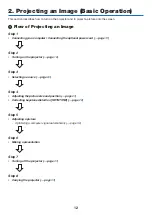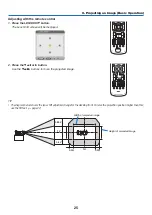
13
2. Projecting an Image (Basic Operation)
Connecting Your Computer/Connecting the Power Cord
NOTE:
• Install a lens before performing the following steps. (
→
page
1. Connect your computer to the projector.
This section will show you a basic connection to a computer. For information about other connections, see “(2)
Connect the computer cable (VGA) between the projector’s COMPUTER 1 IN connector and the computer’s port
(mini D-Sub 15 Pin). Turn two thumb screws of both connectors to fix the computer cable (VGA).
2. Connect the optional power cord to the projector.
WARNING: TO PREVENT FIRE OR SHOCK, DO NOT EXPOSE THIS UNIT TO RAIN OR MOISTURE.
DO NOT USE THIS UNIT’S PLUG WITH AN EXTENSION CORD OR IN AN OUTLET UNLESS ALL THE PRONGS
CAN BE FULLY INSERTED.
• Use the VOLTAGE SELECT switch according to the voltage being used. Select “100V” for 100 to 130V and “200V”
for 200 to 240V.
Important Information:
• When plugging in or unplugging the optional power cord, make sure that the main power switch is pushed to the
off [O] position. Failure to do so may cause damage to the projector.
• Do not use a three-phase power supply. Doing so may cause malfunction.
First connect the optional power cord’s three-pin plug to the AC IN of the projector, and then connect the other plug
of the optional power cord in the wall outlet.
COMPUTER 1 IN
Make sure that the prongs are fully inserted into
both the AC IN and the wall outlet.
Main power switch
To wall outlet
Using the Optional Power Cords
Purchase and use the optional power cord suitable for your country or region.
For North America: NP01PW1
For Europe/Asia/South America:
NP01PW2
For Japan: NP01PW3
(
→
page
)






























